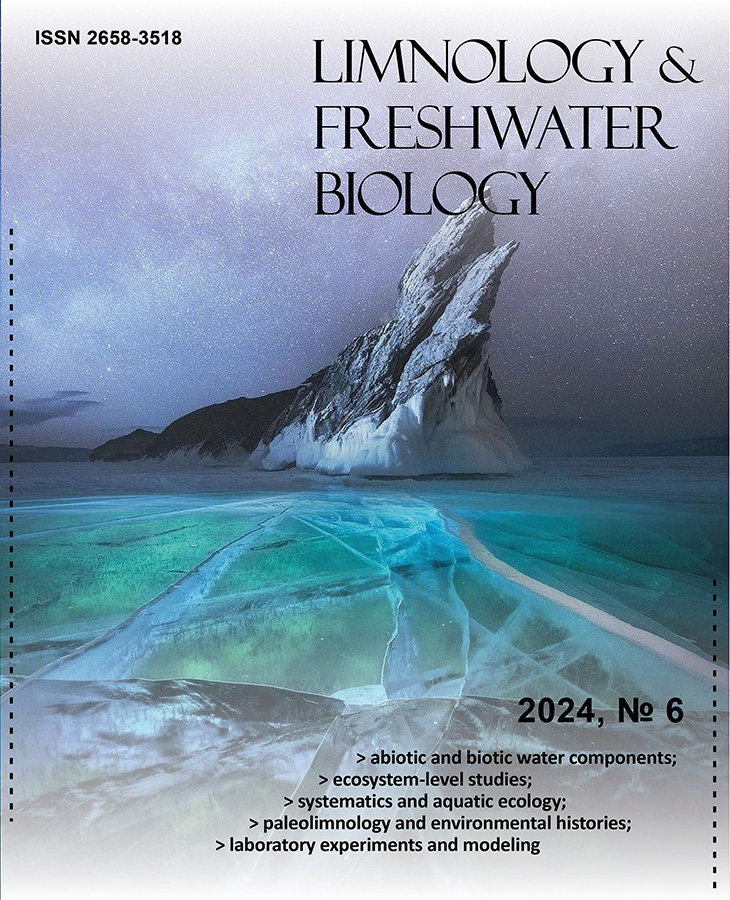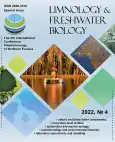Application of European diatom indices for paleolimnological reconstructions of Lake Tavatui (Middle Urals, Russia) ecosystem changes
- Authors: Maslennikova A.V.1, Gulakov V.O.1
-
Affiliations:
- South Urals Federal Research Center of Mineralogy and Geoecology UB RAS
- Issue: No 4 (2022)
- Pages: 1492-1494
- Section: Articles
- URL: https://journal-vniispk.ru/2658-3518/article/view/290435
- DOI: https://doi.org/10.31951/2658-3518-2022-A-4-1492
- ID: 290435
Cite item
Full Text
Abstract
Diatom European indices are applied for assessment of water quality and eutrophication. The research is focused on application of diatom European indices for paleolimnological reconstructions of Lake Tavatui (Middle Urals, Russia) ecosystem changes. Among 23 calculated indices, only IBD, IPS, and IDG were compliant with the condition for the availability of ecological information for at least 60% of the assemblage species and the 60% abundance of these species for all samples of sediments core. There was no correlation between indices due to the different system of counting and pollution sensitivity of species in the same genera in the indices system. Only IPS have negative correlation with diatom inferred total phosphorus. The results based on IBD was not reliable due to its correlation with certain species and its substantial impact into index value. Inapplicability of IDG was due to the fact that this index is based on the ecology of genus which often contains species with different ecology.
Keywords
Full Text
1. Introduction
European diatom indices are widely used in assessment of water quality and eutrophication. To determine the drivers of lake eutrophication, it is necessary to study the dynamic of lake ecosystems using palaeolimnological reconstructions. A study conducted on 72 lakes of the Southern and Middle Urals showed that 14 of the 23 European diatom indices correlated with nutrient variables, despite the difference in sampling methods and the type of aquatic ecosystem for which the diatom index was developed (Maslennikova et al., 2022). The purpose of this research is to test European diatom indices for paleolimnological reconstructions of Lake Tavatui ecosystem changes.
2. Materials and methods
In this study, we calculated diatom indices for the Lake Tavatui (Middle Urals) sediments core. The results of the diatom analysis and diatom-inferred water parameters reconstructions of Lake Tavatui were described in details in previous article (Maslennikova, 2022). European diatom indices were calculated using Omnidia 6.1.4. software (Lecointe et al., 1993). The main reason of diatom indices inapplicability was insufficient representation of diatom species of the Ural lakes in the indices datasets (Maslennikova et al., 2022). So, the interpretation was carried out if the ecological information in index dataset was available for at least 60% of the assemblage species, and the abundance of these species was at least 60% of the assemblage abundance. Pearson correlation was applied to determine the relations between the indices and diatom inferred total phosphorus (DI-TP) and electrical conductivity (DI-EC) of lake water.
3. Results
Only IBD (Biological Diatom Index) (Lenoir and Coste, 1996), IPS (Specific Pollution Sensitivity Index) and IDG (Generic Diatom Index) (Cemagref, 1982) were compliant with the “condition of 60%”. There was no significant positive correlation between these indices (Fig.). IPS and IBD negatively correlated with TP (r=-0.7 for IPS and r=-0.3 for IBD). For lower (11.7-7.9 cal ka BP) and upper (from 7.9 cal ka BP to 2009 AD) part of the core correlations increased (r=-0.8 for IPS and r=-0.4-0.5 for IBD). In addition, IBD correlated with EC (r=0.8). However, when analyzing the upper and lower parts of the core, the correlation disappeared. IDG related to EC (r=-0.7) and TP (r=0.43) for the whole core, to EC (r=-0.5) for the upper part and to TP (r=0.7) for lower part of the core.
Fig. Lake Tavatui sedimentary record of changes in diatom indices, DI-TP, DI-EC and diatom species.
4. Discussion
Theoretically, the indices should positively correlated with each other and had a negative relationship with DI-TP and optionally with DI-EC. The lack of correlation between indices and false positive correlations with DI-TP and DI-EC could be associated with a different way of indices calculating, as well as differences in indicative value and pollution sensitivity of the same species for the indices. The main diatom assemblage shift at 7.9-8.1 cal ka BP was expressed as shift from Staurosira construens Ehrenberg and Pseudostaurosira brevistriata (Grunow) D.M.Williams & Round to Aulacoseira ambigua (Grunow) Simonsen and Aulacoseira granulata (Ehrenberg) Simonsen assemblage. According IBD system, Aulacoseira ambigua and A. granulata are more likely to occur in waters of a lower class than Staurosira construens and Pseudostaurosira brevistriata (Coste et al., 2009). Therefore, with an increase in the number of Aulacoseira ambigua, the IBD index sharply decreased, which caused a correlation with EC. Indicative value and pollution sensitivity for above mentioned species in IPS and IDG system are almost the same (Cemagref, 1982). The differences in these indices are due to the fact that IDG is based on the ecology of genus. The main differences between IPS and IDG were observed in periods of Nitzschia denticula Grunow increase (Fig.). This species characterized by high pollution sensitivity in IPS system. At the same time, the genus Nitzschia have low pollution sensitivity in IDG system. So, then IPS increase, IDG decrease.
5. Conclusions
Thus, assessment of European diatom indices for palaeolimnological reconstructions of Lake Tavatui showed reliable results only for IPS, which had a strong correlation with DI-TP. Indices mismatch was explained by the different system of diatom indices counting, as well as the different pollution sensitivity of species in the same genera.
Acknowledgments
The research was supported by the Russian Science Foundation (Grant No. 21-17-00071, https://rscf.ru/project/21-17-00071/).
Conflict of interest
The authors declare that there are no known competing financial interests or personal relationships that could have appeared to influence the work reported in this paper.
About the authors
A. V. Maslennikova
South Urals Federal Research Center of Mineralogy and Geoecology UB RAS
Author for correspondence.
Email: adenophora@inbox.ru
Russian Federation, territory of the Ilmeny State Reserve, Miass, Chelyabinsk district, 456317
V. O. Gulakov
South Urals Federal Research Center of Mineralogy and Geoecology UB RAS
Email: adenophora@inbox.ru
Russian Federation, territory of the Ilmeny State Reserve, Miass, Chelyabinsk district, 456317
References
- Cemagref. 1982. Etude des méthodes biologiques d’appréciation quantitative de laqualité des eaux [Study of biological methods for the quantitative assessment of water quality]. Cemagref, Division Qualité des Eaux, Lyon.
- Coste M., Boutry S., Tison-Rosebery J. et al. 2009. Improvements of the Biological Diatom Index (BDI): description and efficiency of the new version (BDI-2006). Ecological Indicators 9(4): 621-650. doi: 10.1016/j.ecolind.2008.06.003
- Lecointe C., Coste M., Prygiel J. 1993. Omnidia: software for taxonomy, calculation of diatom incices and inventories management. Hydrobiologia 269/270: 509-513. doi: 10.1007/BF00028048
- Lenoir A., Coste M. 1996. Development of a practical diatom index of overall water quality applicable to the French national water Board network. In: Whitton B.A., Rott E. (Eds.), Use of algae for monitoring rivers, vol. II. Innsbruck, Austria, pp. 29-43.
- Maslennikova A.V., Gulakov V.O., Aminov P.G. et al. 2022. Possibilities of European diatom indices in assessment of lakes ecological state changes in the Urals (Russia). Trudy KarNC RAN [Proceedings of the Karelian Research Center of the Russian Academy of Sciences]. (in Russian) (in press)
- Maslennikova A.V. 2022. Holocene environments in the Middle Urals: paleolimnological proxies from the Lake Tavatui (Russia). Quaternary International 622: 51-64. doi: 10.1016/j.quaint.2022.02.033
Supplementary files











